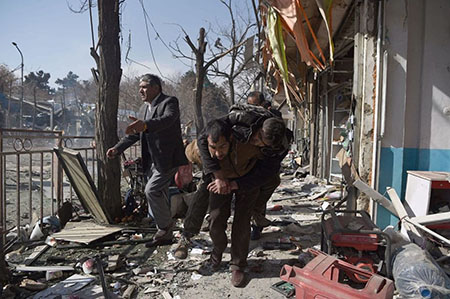By Pamela Constable
ISLAMABAD, Pakistan — An ambulance packed with explosives that detonated in Kabul and a pedestrian suicide bombing outside a Shiite shrine there were among the deadly incidents that led to a near-record 2,258 civilian casualties in Afghanistan during the first quarter of this year, U.N. officials reported this week.
According to the U.N. Assistance Mission in Afghanistan, there were 763 conflict-related civilian deaths and 1,495 injuries across Afghanistan between January and March. Those figures were comparable with record-high levels of casualties reported during the same period in the past two years, as aggressive attacks by Taliban insurgents and the Islamic State increased.
In an especially alarming sign, the report indicated the number of casualties caused by suicide bombings or by complex insurgent assaults with both bombs and guns was twice as high as during the first quarter of 2017, even as thousands of U.S. military troops embarked on an ambitious effort to expand and bolster the performance of Afghan defense forces.

Afghan volunteers carry a body at the scene of a car bomb explosion in Kabul on Jan. 27. (Photo: Wakil Kohsar/AFP/Getty Images)
The Western-backed war effort has continued to suffer from a number of problems, including low morale among Afghan troops and corruption among military officials. The Taliban have failed to capture any cities but control large portions of territory across the country, more than at any time since the war began in 2002. The Islamic State has mainly targeted urban Shiite communities, with dozens of attacks.
The largest single spike in civilian casualties came during a 10-day period in January, when both Taliban and Islamic State forces attacked numerous targets in Kabul, killing more than 150 people and wounding hundreds. They included the ambulance suicide attack near a hospital, a commando siege of a luxury hotel and an armed raid on a military training facility.
A second deadly trend during the first three months of the year was a string of bombings and other attacks on Shiite communities, mosques and other targets, both in Kabul and in other cities including Herat and Mazar-e-Sharif. Most were claimed by the Islamic State, an extremist Sunni Islamic group. One March bombing near a shrine in Kabul, where Shiites had gathered to celebrate the Persian new year, killed 30 people and wounded scores.
“Afghan civilians continue to suffer, caught in the conflict, in ways that are preventable. This must stop now,” Ingrid Hayden, the U.N. Secretary General’s deputy special representative for Afghanistan, said in a statement. “All parties to the conflict . . . must do everything in their power to protect civilians from harm.”
The U. N. report said casualties caused by pro-government forces so far this year were slightly lower than the first part of last year, but that positive news was immediately dampened by the deadly Afghan air force bombing of a religious school in Kunduz province April 2, in which at least 30 civilians, including young students, were reportedly killed. Some residents said the number of dead was 50.
Afghan military officials said the air attack was aimed at Taliban leaders in the compound and that several of them were killed. The location of the seminary, Dasht-i-Archi district, is a longtime Taliban stronghold that Afghan forces have been unable to recapture despite months of intense fighting and air raids.
Afghan and international human rights groups condemned the aerial bombing, saying several hundred people had gathered at the location for a ceremony and that officials did not do enough to protect civilians. The incident highlighted the problems of the nascent Afghan air force, and it was reminiscent of the controversial 2015 U.S. airstrike in Kunduz city that mistakenly targeted an emergency hospital, killing 42 people.
“The laws of war permit attacks only against military objectives,” Patricia Gossman of Human Rights Watch wrote online after the attack. “Bombing the madrassah, where hundreds of civilians had gathered, would be a classic example of a disproportionate attack.” She noted the U.S. military “plays a crucial role in all aspects of Afghan air operations” and “provides all training” as well as attack aircraft to the force.
Ten days later, an especially deadly stealth attack by the Taliban in Ghazni province reinforced the impression that its forces are continuing to gain ground with aggressive military tactics, despite recent overtures from the Kabul government about reviving peace talks, and even in areas of the country that have been considered relatively safe.
On April 12, Taliban forces overran the Khwaja Omari district of Ghazni, killing the district governor and numerous policemen. The raid was carried out at 2 a.m., and the government compound was set on fire as the insurgents left the area. U.S. officials had listed that district as “government influenced,” meaning it was largely under state control and had minimal Taliban presence.
“The fact that the Taliban was able to easily overrun the Khwaja Omari district center indicates that the Taliban presence . . . is far greater than assessed” by the U.S. military, wrote Bill Roggio, editor of the Long War Journal. He said “the security situation in Afghanistan has progressively declined” since most U.S. forces withdrew in 2014.



